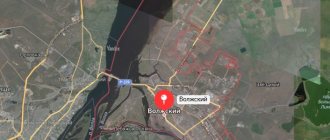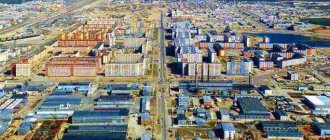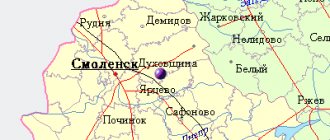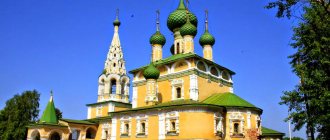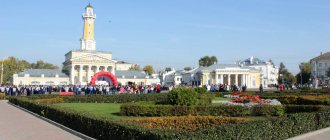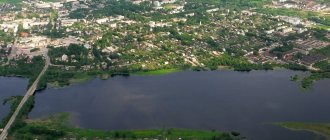KONDOPOGA
KONDOPOGA, a city in Russia, in the southern part of Karelia, the center of the Kondopoga region. Population 29.7 thousand people. (2019). Located on the shore of Kondopoga Bay of Lake Onega. Railroad station.
Story
It was first mentioned in 1495 as a village, from the mid-16th century. village of Kondopoga. In 1797–1920, the volost center of the Petrozavodsk district of the Novgorod province (1796–1801), Olonets province (1801–1920). In the 18th–19th centuries. an important transshipment point during the transit of the so-called. Tivdiya marble to St. Petersburg (the deposit near the village of Tivdiya, in the vicinity of Kondopoga, was discovered in the mid-18th century, industrial development ceased at the beginning of the 20th century). In 1916, constant traffic began on the Murmansk railway.
In January 1918, Soviet power was established. In 1920, Kondopoga from Petrozavodsk district was transferred to the Karelian Labor Commune (in 1923 it was transformed into the Karelian Autonomous Soviet Socialist Republic). In the 1920s A hydroelectric power station and a pulp and paper mill were built in Kondopoga. Since 1938 the city. During the Great Patriotic War it was occupied by Finnish troops from November 3, 1941 to June 28, 1944. Liberated by Soviet troops during the Svir-Petrozavodsk operation (June - August 1944). In 1959, Kondopoga was declared an All-Union Komsomol shock construction site, which contributed to the development of the city in the economic, social and cultural spheres. Regional center of the Karelian Autonomous Soviet Socialist Republic (1927–40, 1956–92), Karelo-Finnish Autonomous Soviet Socialist Republic (1940–56), and the Republic of Karelia (since 1992).
Architecture. Cultural centers
Kondopoga. Assumption Church. 1774 (burnt down in 2018). Photo by P. S. Pavlinov
On the southern outskirts of the city, in its old part, on the shore of the Kondopoga Bay, stood the wooden Assumption Church (1774, restored in 1927 and in the 1950s under the direction of A.V. Opolovnikov), one of the most beautiful tented churches of the Russian North. The high quadrangle of the central part turned into a 2-tier octagon, ending with an expansion (fall), which served as the basis of a slender tent (the total height of the church is 42 m). From the east, the main volume was adjoined by a rectangular altar area with a keel-shaped covering (“barrel”), from the west – a wide refectory and a vestibule with a common gable roof, with 2 hanging porches and staircases-entrances, symmetrically located from the north and south. The outside of the church was decorated with a belt of gabled pediments on an octagon, carved pillars of the porches, openwork roof valances and figured ends of its beams. The interior of the temple at a height of 5 m was covered with a suspended ceiling with paintings (“sky”). There was a 5-tier carved iconostasis, in the refectory there were 2 carved pillars with twisted interceptions and figured brackets. On August 10, 2018, the church burned down.
Photo by M. V. Nevskaya Kondopoga. Arch with carillon at the Sports Palace. 2001.
In the center of the city there are hydroelectric power stations (1923–29, project 1915–16 by engineer G. O. Graftio; 2nd stage - 1937–41), a paper mill (1923–41). Among the monuments of modern construction: Sretenskaya Church (early 2000s), Lutheran Church of the Ascension of Christ (2003–04, architect S. Kokkonen), wooden Church of the Nativity of Our Lady (2006–07). Monuments to S. M. Kirov (1979, sculptor O. Z. Gedes), M. I. Kalinin (1988, sculptor B. I. Dyuzhev). Museum of Local Lore (1984). In the Palace of Arts (at the end of the 1990s, rebuilt from the Wallet Culture House, 1936), a large organ with electromechanical transmission was built (2000, German company Beckerath). 2 automatic carillons were installed (manufactured by the Dutch company Petit & Fritsen), one of them (23 illuminated bells, computer control and keyboard with electronic transmission) is located at the Sports Palace on a special arch (2001).
Farm
The leading enterprise is the Kondopoga Pulp and Paper Mill (one of the Russian leaders in the production of paper, including newspaper, also producing consumer paper, wrapping paper and paper for corrugated cardboard, technical lignosulfonates and feed yeast). Wood is harvested (Kondopoga Timber Industry Enterprise, 1929; since 2021), production of shungite crushed stone (Kondopoga Shungite Plant, 1972), flour and semolina (Kondopoga Bakery Plant). Kondopoga hydroelectric power station (capacity over 25 MW; part of the Suna hydroelectric power station cascade).
Neighborhood
Near Kondopoga there are: in the village of Lychny Ostrov, on the island of the same name, on Lake Sandal, - the tented church of Saints Peter and Paul (1620); in the village of Kolgostrov - the Chapel of the Ascension (early 18th century); in the village of Pegrema - the chapel of St. Varlaam Khutynsky (1770s); pavilions and churches of the Martialnye Vody balneological and mud resort; wooden chapels from the 2nd half of the 18th – mid-19th centuries. in the villages of Myanselga, Lukin Ostrov, Mikheeva Selga, Pavlovitsy, Ershi, Maloe Lizhmozero; in the village of Konchezero - buildings of an iron and copper smelting plant of the 18th–19th centuries. (founded in 1706 by decree of Peter I), brick Trinity Church in Russian style (1866); in the village of Belaya Gora - a church in honor of the icon of the Kazan Mother of God (1856); in the village of Meloy Guba - St. Nicholas Chapel (1890–95); in the village of Girvas - the wooden church of St. Panteleimon (2002–07); in the village of Yanishpol - a wooden temple of the martyrs Vera, Nadezhda, Lyubov and their mother Sophia (2007–08).
Kondopoga
(Republic of Karelia)
OKATO code:
86215501
Founded:
1938
City since:
1938 City of district subordination (Kondopoga district of the Republic of Karelia)
Center:
Kondopoga district
Telephone code (reference phone)
| 81451***** | — |
Deviation from Moscow time, hours:
0
Geographic latitude:
62°12′
Geographic longitude:
34°16′
Altitude above sea level, meters:
60 Sunrise and sunset times in the city of Kondopoga
Salary
- Low income - 8-15 thousand rubles
- Average income - 16-24 thousand rubles
- High income - from 25 thousand rubles and above
The jobs most often require sellers, warehouse workers, bank dispatchers and doctors.
“I was born and raised in Kondopoga,” says our journalist Alla Konstantinova. “Only a few of my classmates remained to live in the city. Some work as a lawyer, some as a teacher, some as a store manager. Most left for Petrozavodsk and St. Petersburg. It feels like the prosperity of the city has disappeared along with our childhood... When I come to Kondopoga and walk through familiar places, I feel sad. It’s like visiting an elderly relative who was healthy and happy just yesterday, but now he can’t get out of bed.
View this post on Instagram
A post shared by Overheard Kondopoga (@pod_knd)
Products
Shawarma - 200 rub. Chicken (fillet) - 290 rub. Pork (boneless)—from 390 rub. Tomatoes - from 50-100 rubles. Cucumbers - 40-70 rub. Bananas - 50-60 rubles. Apples - 33-50 rubles (Russian), imported - from 80 rubles Oranges - 90-130 rubles.
Ordering pizza at home - 350-370 rubles.
On average, I buy the following products per day: milk 1 liter - 53 rubles, kefir 0.5 - 27 rubles, sliced loaf - 26 rubles, small bread - 18 rubles, cottage cheese in a pack - 53 rubles, sour cream - 63 rub.,” says Inna. - For a week I buy 10 juices 0.2 for 21 rubles - for children at school every day, Natura cheese 400 g for 329 rubles, kg of minced meat - 360 rubles. or meat - 350 rubles, a dozen eggs - 58 rubles + about 1000 rubles more. cookies, pasta, cereals, vegetables and fruits, sugar, butter.
Versions of the causes of the riots in Kondopoga
Russian media publish various versions of the reasons for the unrest in the Karelian city of Kondopoga, which ended with demands from local residents to evict all people from the Caucasus, take away their restaurants and shops, and ban them from trading in the market.
Let us recall that the cause of the unrest was a mass fight between local residents and immigrants from the Caucasus, during which 27-year-old Grigory Slizov and 32-year-old security guard of the central district hospital Sergei Usin were killed. According to the Ministry of Internal Affairs, three victims in the fight in the restaurant remain in serious condition. They are in intensive care. All those killed or seriously injured had stab wounds.
According to Komsomolskaya Pravda, there are four main versions.
According to the first - economic (it is defended by the Ministry of Internal Affairs) - the cause of the pogroms was the conflict between local criminal groups and the Chechen diaspora. The parties allegedly could not agree on the division of city property. The head of Karelia, Sergei Katanandov, has already promised to “find out whether the competition between Transcaucasian entrepreneurs and local businesses is so serious in Kondopoga.” And in any case, “local businessmen will be able to work in the market, which until then was purely Caucasian.”
The Chaika restaurant, according to the newspaper, was handed over to Imanov, a native of the Caucasus, by the local authorities. At one time, they wanted to sell “Chaika” into private ownership, allegedly for 20 million rubles, but in the end they rented it out. Mayor Anatoly Papchenkov said that the issue of terminating the lease agreement is now being resolved. There are about 400 private entrepreneurs in the Kondopoga district, and only 15 - 20 of them are Caucasians.
The second version of the reasons for the events in Kondopoga is political. A GZT.ru source in the government of Karelia reported that activists of several parties almost immediately after the fight rushed to call the townspeople and throw out leaflets, calling on all locals to go to the rally, and representatives of Patriots of Russia, Rodina, and the Liberal Democratic Party spoke on improvised stages.
The presence of deputies of the local City Assembly and representatives of the organization DPNI (Movement against Illegal Immigration) at the people's meeting (which preceded the pogroms) also speaks in favor of the political version. DPNI claims that they learned about the murder of four Russians by Chechens in the Chaika restaurant on the Internet and came to support local like-minded people.
Law enforcement agencies of Karelia, in fact, admitted that the riots were well planned. The prosecutor's office is now looking not only for the instigators of the riots that have already passed, but is also waiting for the repetition of similar events according to the same pattern in other cities, Deputy Prosecutor of the Republic Pyotr Klemeshev said in an interview with Echo of Moscow.
The leader of the unregistered Movement against Illegal Immigration, Alexander Belov, does not hide the fact that he took an active part in the rally on September 2 in Kondopoga. “I was actually present at the meeting and helped people formulate demands,” he said, “but in fact my function was reduced to the fact that I held a megaphone in my hands, with which the mayor, the police chief and everyone who wanted spoke.”
The mayor of Petrozavodsk accuses Muscovites and St. Petersburg residents of the pogroms in Kondopoga. Viktor Maslyakov spoke about this at today’s meeting of Karelian authorities with representatives of the Chechen diaspora. According to him, specially trained young people from Moscow and St. Petersburg appeared in the city to incite national conflicts.
The mayor of Kondopoga, Alexander Popchenkov, does not deny the interethnic version. Over the past few years, the number of natives of the Caucasus has increased in the city, which many did not like. In addition, residents of Kondopoga are confident that Caucasians in this town have placed themselves above the law. “The main reason was that before our eyes, a group of representatives of another nation behaved impudently and defiantly, ignoring the mentality of our people. It takes a long time to convince the northern people. In general, I understand the feelings of those people who took to the streets. We will do everything possible to ensure that the instigators are punished and the rights of Russian citizens, including natives of the Caucasus, are respected,” said the head of Karelia Katanandov.
There is also a fourth version - a household version. On Wednesday, August 30, in the evening, a group of tipsy people tried to enter the restaurant, which was closed for special services (a wake was being held there). The Chechen bartender did not let them in, for which he was beaten. The Chechen called for help, armed with knives and bats.
“That evening some company, our criminal guys, were hanging out in the restaurant. They ordered expensive vodka. And they brought it, under the guise of being expensive, in the same bottle. The guys were outraged and a showdown with the bartender began. We fought with fists; none of us had any weapons. And the bartender called his bandits, and they arrived with weapons. Those guys who started the dismantling were no longer there. The Chechens simply walked down the street and slaughtered everyone who came to hand,” a saleswoman from an auto parts store closest to Chaika told Moskovsky Komsomolets, who, according to her, knows all the participants in the events.
Let us remind you that the unrest in Kondopoga began on Saturday, September 2, in the evening after a spontaneous rally at which townspeople demanded to punish Caucasians suspected of killing local residents. Also at the meeting, demands were made to free the local market from traders from the south so that local residents could trade there. The Kondopoga administration agreed to these demands, but this did not calm the protesters, writes NEWSru.com.
According to eyewitnesses, about 100 young people, fueled by alcoholic drinks, moved along the city streets, blocking the movement of vehicles and throwing stones at passing cars. The police made no attempts to stop them, apparently for fear of provoking more serious unrest. Several hundred of the protesters went to the Chaika restaurant.
The police tried to prevent the destruction of the restaurant, but after a while they retreated, and the crowd first threw stones at the restaurant, and then, rushing inside, set fire to the back room. After police officers pushed people back and firefighters put out the fire, separate groups of protesters began to destroy commercial tents belonging to businessmen in one of the Caucasian republics.
At 22.00 Moscow time on Sunday, September 3, the crowd again gathered near the restaurant and set it on fire. Then riot police detachments, transferred to Kondopoga from the capital of Karelia, Petrozavodsk, came into action. The riot police divided the crowd into several small groups and then dispersed them throughout the city. There have been no reports of casualties over the past 24 hours.
According to a source in the police department, during the arrest the police “used force only in exceptional cases.” “If we saw direct aggression, when bottles were used, then we removed such people from the crowd. But mostly they tried to convince,” said the interlocutor of RIA Novosti.
According to the police, almost all representatives of national minorities, including the Chechen diaspora, left Kondopoga. The authorities urgently evacuated 60 people to Petrozavodsk. Several dozen Caucasians moved to the Kondopoga suburb of Berezovka, where they are hiding with relatives.
Administrative penalties in the form of arrest for up to 15 days were applied to 25 of the 129 detainees for participation in mass riots, the Karelia prosecutor's office reported on Sunday. As stated in the official statement of the republican prosecutor's office, the case against another 25 riot participants is under investigation. About 50 witnesses to what happened were questioned. The case is being investigated by the Department for Particularly Important Cases of the Prosecutor's Office of Karelia.
According to the Ministry of Internal Affairs of the republic, with the assistance of the public, three representatives of Azerbaijan were detained who participated in a fight in the Chaika restaurant on the night of August 30, where two Slavs were killed. Earlier, three more representatives of the Azerbaijani diaspora were detained. They were charged under Article 105 of the Criminal Code of the Russian Federation - premeditated murder. At the same time, three other active participants in the fight from among local residents remain at large. This was reported to ITAR-TASS by the Minister of Internal Affairs of Karelia, Major General of Police Dmitry Mikhailov. “We know where to look for them and this is only a matter of short time,” the minister noted.
According to him, three more active participants in the fight from among people from the Caucasus - Islam Said-Eminovich Magomadov, Aslanbek Musaevich Bakanaev, Said-Magomed Abdulmethylinovich Edilsultanov - came to the prosecutor's office themselves and testified about what happened. As the minister noted, the leaders of the Caucasian diasporas in Karelia played a big role in the confession of these participants in the fight.
